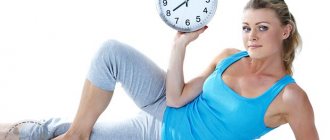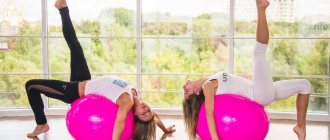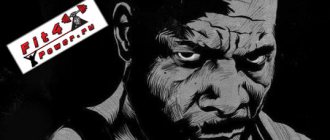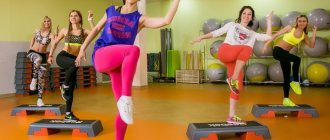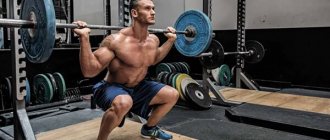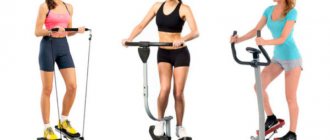Rules for performing the exercise
- Lie on your back, bend your knees at right angles, and place your feet on the floor (or on a bench). If you are using an elevated platform, place your feet 10cm apart. Keep your hands behind your head. Tip: don't touch your fingers.
- With your lower back pressed into the floor (this will force your abdominal muscles to work harder), begin to lift your shoulders.
- As you exhale, press your lower back into the floor as hard as you can. Keeping it motionless, raise yourself 10 cm by tensing your abdominals. Tip: do the exercise slowly, without jerking.
- After a second pause while inhaling, slowly lower yourself to the starting position.
- Repeat the recommended number of times.
Variations: You can perform the exercise with additional weight, on an incline bench, or with a fitball (gymnastic ball).
Among the basic variations, consider crunches with arms above your head and lateral movements, which can diversify your workouts without changing your body position.
Lie down on an incline bench. Place one hand on the back of your head, the other on your thigh. As you exhale, twist, turning your body to the left until your right elbow touches your left knee. Repeat as many times as necessary and switch sides.
Crunches with arms above head
Lie on your back, bend your knees, and place your feet half a meter apart. Raise yourself 10 cm from the floor, at the same time stretch your right hand towards your right heel. Exhale and lower yourself. Repeat on the other side.
Alternating side crunches
Let's take a closer look at the working muscles, the benefits and contraindications for performing the exercise, as well as many other versions of its implementation.
Variations
After mastering the classic technique of twisting on a ball, you can move on to performing various variations of this exercise.
With your feet up
Performed in this order:
- Lie on the mat with your back and grab the ball with your feet. Legs can be bent at the knees or kept straight. The best option is to alternate both positions.
- Place your arms along your body, palms down.
- Tighten your abdominal muscles, stretch your shoulders towards your knees.
- Slowly return to the starting position, and do not lower your feet to the floor, but keep the ball suspended with them.
Perform the exercise until you feel a burning sensation in your stomach, and then rest for half a minute and repeat 2 more times.
Russian twist
The exercise is complicated by turning the body, which allows you to additionally work the oblique muscles. The Russian twist is made in this order:
- Take the classic starting position, but extend your arms in front of you and join your palms.
- With an exhalation, lift your back off the floor and turn your body to the left side, where you point your outstretched arms.
- Inhale and return to the starting point. Do the same thing, but to the right.
It is recommended to perform 15 repetitions on each side during the workout.
Oblique crunches
Such exercises also help to work the lateral abdominal muscles. They need to be done as follows:
- Lie on the ball with your left side.
- Place the arch of your left foot on the floor, bring your right foot forward and step on the floor with the entire sole. To maintain balance with crossed legs, the exercise should be done against a wall.
- Move your right hand to the back of your head, and keep your head in line with your body.
- Tear off the top of the body and bend towards the waist.
- At the point of maximum bending, linger for 3 seconds and return to the starting position.
Oblique twists should be performed 15 times on each side.
In addition to classic and reverse crunches, there are other variations of the exercise that will allow you to quickly achieve the desired relief:
- With a twist. You need to perform the same actions as with the main crunch, only instead of raising both shoulders, you need to raise one shoulder in the opposite direction: raise your right shoulder to the left and vice versa. Helps work the obliques, as well as the upper abdominals.
- Lateral. When taking the starting position, you need to bend your legs at the knees, and then point them in one direction and lower them down until they touch the floor. Then lift your shoulders and perform a regular crunch. Then do the same thing, but in the other direction. Due to the twisted body, you can feel tension in the side. When performing the exercise, it is important not to lift your entire body or lift your lower back off the floor.
- On fitball. This exercise is an analogue of the classic crunch, but it is performed on a fitball - a gymnastic ball. When taking the starting position, you need to lie on the fitball, focusing on your bent legs, and put your hands behind your head or cross them on your chest. Next, you need to slowly raise and lower your shoulders. During the exercise, it is prohibited to bend or bend the lumbar area and the back as a whole.
- Diagonal. You need to lie on your back, bend your knees, and then place the foot of one leg on the knee of the other leg. The usual twists are performed, with the exception that after raising the upper part of the body, you need to perform a diagonal turn in the opposite direction, that is, turn your left shoulder to your right knee and vice versa. It is important to make turns with your shoulder, and not to reach your knee with your elbow. When performing the exercise, you should not lift your hips off the floor.
- Reverse crunch with bent legs. You need to lie on your back, bend your knees, and spread your arms to the sides, resting your palms on the floor. Without a jerk, pull your knees to your chest and return to the starting position, but you should not touch the floor with your feet. To increase the effectiveness of the exercise, it should be performed on an incline bench. This is a great crunch for your lower abs.
- Scissors. Lie on your back, raise your legs straight until they form 90 degrees. Press your lower back to the floor, and extend your arms along your body or place them under your buttocks. You need to alternately lower your legs above the floor level and raise them to the starting position. It also helps to work your lower abs. From the same starting position, you can perform the “bicycle” exercise.
- Book. Lie on your back, raise your arms up and stretch out your legs. Raise your upper and lower limbs at the same time, as if closing a book, and then slowly lower them. This kind of crunch is difficult to perform in the initial stages of training, so it’s worth returning to it after mastering the classic technique.
- Reverse hanging crunch. Take a hanging position on your elbows. Raise your legs parallel to the floor, stay in this position for 1-2 seconds and return to the starting position. A very effective exercise for the lower abs.
READ MORE: Triple jumping rope exercise technique and crossfit complexes
What are crunches?
Twisting, also called crunches, are exercises aimed at reducing the gap between the chin and the pelvis when bending the back in the spine. These are the best exercises for working all abdominal muscle groups. Their correct and systematic implementation leads to the appearance of six-pack abs that everyone desires.
The effectiveness of these exercises is achieved through powerful contractions of the abdominal muscles. If you do crunches at a fast pace, then the formation of a metabolic press gradually occurs, which activates the resorption of fats deposited in specific areas of the abdomen. Over time, fat deposits are reduced, the stomach is tightened and muscle relief, which is commonly called cubes, begins to appear. An example of performing crunches on a fitball is shown in the illustration.
Crunches help tone not only the abdominal muscles, but also the tissues of the body, which helps strengthen them and prepare them for powerful physical activity. During the exercise, blood flow accelerates and the blood reaches deep-lying muscles and even the spinal region. And this is important for accelerating the transfer of nutrients throughout the body in order to maintain health at the proper level.
Ab crunches have huge health benefits. It not only helps to cope with excess fat and create abdominal relief, but also includes all the muscles of the abs, hips, buttocks and back. Thanks to this, the lower vertebral part is strengthened and fixed, which leads to the formation of correct posture. With the development of the abdominal muscles, the torso becomes more mobile, and discomfort when moving in different directions is eliminated.
Crunches in the gym
Today there are a large number of crunching machines, including those with rollers or straps, but they all work on the same principle, helping to work the abdominal muscles and obliques. The crunch is performed in this order:
- Prepare the simulator by adjusting it according to your height and setting the desired weight. At first, you should limit yourself to medium weights, with which you can perform about 10-15 repetitions. Then the load can be gradually increased. You should also adjust the seat so that your feet comfortably rest on the floor, and the back of your shoulders rests comfortably on the cushions of the exercise machine. If the device has a bolster that you need to rest your chest against, you need to make sure that it is convenient to control your body position.
- Sit in the prepared simulator, grab it by the handles with your hands, and rest your shoulders on the pillows. If there is a bolster in front of your chest, you should move your arms back so that they do not pull the body forward and reduce the load on the abs.
- In the starting position, twist slightly so that the tiles of the exercise machine rise slightly.
- At the exit, perform a twist and hold at the top point for 1-2 seconds to achieve maximum muscle contraction. When twisting the body, you need to pull your head towards your pelvis, and not just bend forward. In this case, it is strictly forbidden to turn your head, since in this case, while working with weight, you can get injured in the cervical spine.
- As you inhale, slowly return to the starting position without relaxing the muscles. In general, the abs should be kept tense during the entire approach. If you feel very tired, you can take a break for a few breathing cycles and continue training.
READ MORE: A set of exercises at home for women that will help you lose weight
Advantages
Ab crunches are included in various training systems. The exercise is used by leading fitness trainers, where it occupies an important place in both women's and men's training programs.
The scale and significance of crunches is determined by the following advantages:
- Comprehensive ab workout. Press crunches are performed in different variations. You can use several exercises in one complex to maximize the load and increase the effectiveness of your workout.
- Helps stretch the spine. The exercise has a beneficial effect on the mobility of the back, stretches it and eliminates muscle tension, as well as pain in the spinal region.
- Multifunctional exercise. You can do crunches anywhere. The technique does not require the use of additional equipment, so going to the gym to perform crunches is not necessary.
- Helps correct your figure. When crunching, not only the abdominal muscles work, but also other parts of the body. Physical activity is distributed almost throughout the body, which leads to additional work of other muscles and burning of calories.
Benefits of crunches
This element is used in both women's and men's fitness programs. Its popularity is due to its beneficial properties:
- High-quality press work. There are many variations of crunches. If you correctly combine several similar exercises in a program, the abdominal muscles will receive a complex load, which will increase the effectiveness of the training.
- Improved spine flexibility. Twisting has a positive effect on the extensibility of the vertebrae, improves overall back mobility, and relieves pain associated with muscle strain.
- Universal application. Many exercise options do not require the purchase of additional sports equipment, so crunches can be done not only in the gym, but also at home.
- Figure correction. Twisting from different positions indirectly affects other muscle groups. For example, when performing an exercise with your back resting on a fitness ball, your hips and buttocks are additionally loaded, holding the pelvis suspended. Due to this, there is an increased consumption of calories and, as a result, weight loss.
Advice for newbies! There is no need to train your abs on a separate day. The abdominal muscles are involved in most exercises: deadlifts, presses, squats and others. Therefore, it is better to add 2 different variations of crunches at the end of each lesson. This way you will avoid overtraining your abs and give this muscle group a good workout.
The exercises in question can be used for various purposes:
- to work out the relief (example: high-speed crunches on the floor);
- to increase the strength of the abdominal muscles (example: crunches in a block machine).
What muscles work
Performing crunches involves the following muscles:
- Rectus abdominis muscle - it is responsible for the formation of cubes on the abdomen. It is located from the middle of the chest and reaches the pubis.
- Transverse muscle - located in the lower abdomen and is responsible for breathing during crunches. Works on exhalation.
- Obliques:
External - located on the side of the body, from the sternum. Its main function is to thin the waist. It is involved in work during the load on the internal oblique muscle. Internal - located in the area of the lumbosternal part and close to the groin. Also designed to ensure a slim waist.
- Gluteal muscles.
- Thigh muscles.
- Back muscles.
Correct technique
As already noted, there are many varieties of exercise. To effectively influence the press, twisting must be performed technically correctly. The classic version of the exercise is performed in stages:
- Place on a hard surface - a floor or bench will do.
- Accepting the starting position of the body. You need to lie on your back, bend your legs and place them on the floor at an angle of 90 degrees. Close your hands behind your head, spreading your elbows to the side.
- You can also cross them across your chest to reduce the stress on your spine. The lower back should be pressed to the floor while performing crunches.
- As you exhale, lift your shoulders and shoulder blades off the floor and pull them toward your knees. The gaze should be directed to the ceiling to prevent pressing the chin to the chest. Also, bringing your elbows together is unacceptable. At the highest point you need to linger for a couple of seconds.
- As you inhale, lower your upper back to the floor. To maximize the load, you can keep your shoulder blades on the floor during crunches.
- Relaxing the abdominal muscles before the next crunch.
Execution technique
The classic crunch is performed in the following sequence:
- Take the starting position - lie on the mat, bend your knees, and you can raise your feet to increase the load.
- Cross your arms over your chest. They can also be held behind the head or on the neck, but in this case, many people begin to pull with their hands on the head or neck while doing the twist, which creates unwanted stress on the spine. You are only allowed to slightly support your head or neck with your hands. If this cannot be done, the best solution is to cross your arms over your chest. To increase the load, you can hold dumbbells in your hands.
- Raise your shoulders up to your knees using your abdominal muscles and slightly round them. In no case should you lift your back off the floor, since in this case you can tighten the spinal muscles and also reduce the effectiveness of the exercise itself. So, the lower back should be kept tightly pressed to the floor.
- Direct your gaze to the ceiling and keep your neck straight. This will avoid raising your head and pressing your chin to your chest, which greatly increases the risk of injury.
- Keep your elbows level with your ears if your hands are behind your head. In general, you should not bring your elbows together, because in this case it is easier to touch your chin to your chest.
- As you rise, exhale and tighten your abdominal muscles.
- Stay at the top for 1-2 seconds. Shoulders should be completely off the floor.
- Slowly lower to the starting position while inhaling. You should not suddenly fall to the floor, because the tension when lowering also helps to train the muscles.
- Relax your muscles before the next lift.
When performing the exercise, you need to fully stretch and contract the abdominal muscles, both at the top and bottom points of the movement.
Classic crunches on a fitball are done in this order:
- Take the starting position - lying on the ball. To do this, sit on the ball and slowly slide down, moving your legs forward. You need to stop when the shoulder blades land on the projectile. In this case, you need to press your back against the ball so that the curve of the lumbar region is clearly visible.
- Bend your legs at the knees, spread them wide and place your feet on the floor. You can hold your arms in two ways - crossed over your chest or placed along your body. This arrangement will help prevent neck overload. Advanced athletes can join their hands at the back of the head, since in this case the load increases by 1.5 times.
- Lower the upper point of the body until you feel severe pain in the abdominal muscles. At the same time, it is strictly forbidden to move your neck.
- As you exit, pull your shoulders forward toward your waist, keeping your hips still and focusing on your abdominal muscles. This movement is a twist, causing tension and compression of the abs. It is strictly forbidden to expose your lower back to the ball.
- At the top point, hold for 2 seconds and tense your abdominal muscles as much as possible. In this case, discomfort will be felt in the abdominal area.
- While inhaling, return to the starting position.
READ MORE: Two-handed kettlebell swings, technique and benefits of the exercise
Other exercise variations
Achieving an effective result is impossible without performing a set of exercises, including various variations of crunches.
This is a very important point, since the abs consists of a group of muscles that require action on each one so that the real and visible effect does not take long to arrive.
Reverse crunches
During reverse crunches, active work of the lower abdominal cavity occurs. To burn fat, it is very important to carefully work out this area. The exercise is performed by lifting the legs rather than the body.
Bodymaster.ru recommends Fitness Trainers:
Reverse crunches are performed like this:
- Starting position lying on the floor or on an inclined bench. Hands should be kept along the body or held
- As you exhale, lift your legs up and stay at the trajectory point for a couple of seconds. If you slightly lift your lower back off the floor, your abs will contract more strongly.
- Lower your lower back to the floor and slowly move your legs towards the floor, stopping a few centimeters from it. The legs do not need to be returned to their original position. You need to strive to keep your abdominal muscles tense during the exercise.
Reverse crunches (reverse crunches)
For added strength and resistance, this technique can be performed in a pulley machine.
Reverse crunches lying at the bottom block
Side crunches
This type of crunch is aimed at working the oblique abdominal muscles. When lifting, the body rotates around its axis. The exercise ensures the creation of clear contours on both sides of the abdominal relief.
The execution technique is as follows:
- Lie on the floor, bend your knees at a right angle, put your hands behind your head.
- As you exhale, lift your upper body off the floor and twist to the right, then repeat the same to the left.
- After inhaling, release your body to the floor.
Oblique (lateral) crunches on the floor
Crunches with raised legs
A highly effective exercise because it combines dynamic twisting with static stabilization.
- You need to lie on the floor and raise your legs up, bend them at the knees so that the knees are at right angles to the body. Place your hands behind your head or close your hands on your chest.
- As you exhale, lift your upper body and pull it forcefully towards your knees. You cannot straighten your back and tear off your lower back.
- At the most extreme point, you need to linger for one or two seconds, so that the abdominal muscles are as tense as possible, and then inhale and lower the body to its original position.
Crunches with legs raised
Which can also be performed with some weights.
Weighted crunches
Or raise your hands to the toes of your legs stretched vertically upward.
Torso twisting (hands to toes)
Diagonal crunches
These crunches are also used to work the oblique abdominal muscles. They help reduce your waist size and become slim.
Diagonal crunches are performed as follows:
- Take the starting position: Lie on the floor, bend your knees perpendicular to the floor and press firmly to it. Then lift one leg, bend it and place your foot on the knee of the other leg.
- Lift your upper body off the floor and pull it towards your knees and twist it diagonally. It is important to twist with the shoulder part: turn your shoulder towards the opposite leg and as far as possible to the side.
- As you inhale, lower your torso to the starting position.
Make sure to keep your hips pressed to the floor during crunches.
Double crunches
Performing this crunch puts stress on the upper and lower abdomen. A combination of classic and reverse crunches is used here.
Technique:
- Lie on the floor and lift your legs off the floor, and then bend them slightly. Place your hands behind your head or on your chest.
- Exhaling, do a double twist: the legs are pulled towards the head, and the body, lifting off the floor, is pulled towards the legs.
- At the extreme point, you should fix the position for a few seconds.
- Inhale and lower your legs and body to the floor.
Double crunches
On an incline bench
Using a bench allows you to change the angle of inclination and increase the impact on the abdominal muscles.
Exercises are performed using standard crunches and reverse crunches.
- Take the starting position: lie on a bench and secure your legs with bolsters. Close your hands on your chest.
- As you exhale, perform a classic twist.
- As you inhale, return to the starting position.
If you pump up your abs with shortened dynamic movements, the load and performance increase.
Incline crunches
On a Roman chair
The exercise is performed using a special chair that secures the legs, preventing them from moving. The upper part of the body is always covered.
- Sit on a chair and secure your legs with special bolsters. Place your hands in a position that is comfortable for you.
- Round your back and, as you exhale, twist your body toward your legs. The upper part of the body should be aimed at the knees.
- Inhale and return to the starting position.
If you need to make the exercise more difficult, you can use additional weight by securing it behind your neck or on your chest.
Lifting on an inclined bench (Sitap) with a load
Kneeling in a pulley machine
If you work out in the gym, then using special equipment for crunches would be the best option, since the load can be adjusted on the machine and performing a workout using the wrong technique is practically impossible.
On the simulator, the exercise is performed as follows:
- You need to attach a rope handle to the top rope.
- Stand with your back to the block and take a small step and lower yourself to the floor on your knees.
- The ends of the handle need to be placed behind your back and pressed tightly against the trapezoid.
- As you exhale, twist the upper part of the body towards the knees.
- While inhaling, lift your shoulder girdle without jerking.
Crunches on the upper block
Standing in a pulley machine
The technique for performing the exercise is as follows:
- You need to stand with your back to the block, having first secured the rope handle to the lower cable.
- Stand up straight with your feet shoulder-width apart.
- Place the ends of the handle over your shoulders.
- As you exhale, use twisting movements to pull your body toward the opposite leg.
- Inhale and return to the starting position.
Press crunches from the lower block
On a gymnastic ball
The technique of doing crunches on a gymnastic ball is similar to classic crunches. This exercise is effective because it keeps not only the abdominal cavity, but also the whole body in tone, maximizing the load.
- Place your upper body on a fitball and place your legs bent at right angles on the floor. The pelvis must be lifted off the ball and kept parallel to the floor. Place your hands behind your head.
- Having fixed the starting position, as you exhale, perform standard forward twists.
- As you inhale, lower your body back onto the ball, but leave your shoulder blades hanging.
You can also work the oblique abdominal muscles in the same way by performing lateral crunches.
Crunches on a fitball
Russian crunches
Russian crunches are also called twists. When performed correctly, the internal and external oblique abdominal muscles receive a good load. At the same time, the rectus abdominis and transverse muscles also work. The entire press is carefully worked out. It allows you to reduce the size of the waist and draw out the sides.
- Take the starting position: you need to sit on the floor, and move your bent legs forward a little and fix them on the floor in a static position.
- The body must be moved back at an angle of 45°. Your back should be straight while performing crunches.
- Stretch your arms forward, bringing your hands together.
- Having clearly fixed the body in a stationary position, make alternating turns to the right and left.
Russian crunches
In a more complicated version, this exercise can be performed in a block
Russian crunches on a block while lying on a fitball
or with additional weighting in the form of a pancake / weights / medicine ball.
In a hanging position on your forearms or straight arms
Such crunches are performed in the gym, using special equipment. It has a padded back and stirrups for the hands. The exercise is done in a hanging position. It works great on the lower abdominal cavity.
- Press your back against the soft back part, and place your arms bent at the elbows on the soft bolsters, in a position perpendicular to the body.
- As you exhale, pull your knees towards your chest and hold for a couple of seconds.
- Inhale and return to the starting position.
Reverse crunches with legs suspended
Side plank crunch on elbow
This variation of crunches perfectly works the oblique abdominal muscles.
- Starting position - lie on your side, and then lift yourself up on your elbow, maintaining support only on your legs. The body should be a straight line, and the elbow should be strictly under the shoulder.
- Raise your free hand up.
- As you exhale, twist your torso, bringing your arm toward the opposite armpit.
- Inhale and return to the starting position.
- Repeat the exercise in the same way on the other side.
Side plank crunch on elbow
Crunches in the gym
Today, fitness centers provide their clients with equipped gyms, which always have crunching machines. There are a large number of variations of such simulators, but they have the same operating principle - working out the abdominal muscles. Crunches on the simulator are carried out in the following sequence:
- First, you should adjust the machine to suit you - set the required weight and adjust the seat height according to your height. You should be able to sit comfortably, and you should not feel any strain on your legs or shoulder girdle. It is better to start training with light weights, gradually increasing the load.
- Sit on the seat, grab the support with your hands, and press your upper body into the pillows.
- Twist the body a little so that the tiles of the machine come off a little.
- As you exhale, twist and fix the position of the body at the extreme point for a couple of seconds. The head needs to move towards the pelvis so that the muscles contract better.
- Inhale and smoothly return the body to its original position.
Crunches on the machine
Lateral crunches in hyperextension
Hyperextension is an exercise aimed at developing the muscles of the spinal region. It also affects the gluteal muscles and the back of the thighs. To work out the abdominal muscles, a special hyperextension bench is used.
- Approach the incline bench sideways and rest your hips on it. Place your feet on platforms. Place your hands behind your head.
- As you exhale, tilt your body towards your legs without jerking.
- Inhale and lift your body to the starting position.
You can increase the load by taking on additional weight.
Barefoot crunches
To perform this exercise you will need a block trainer and a special fitness device - bosu. The exercise effectively works the entire abs and helps reduce waist size.
- You need to attach regular handles to the bottom of the block and place the boss in front of the machine.
- Place your back on your barefoot and keep your buttocks a few centimeters off the floor. Grasp the handles of the block.
- Bend your legs at the knees and place them slightly wider than your shoulders. Extend your arms straight forward so that your palms are level with your knees.
- Maintaining the position, as you exhale, lift your body up.
- Inhale and lower to the starting position.
Crunches on a block while lying barefoot
Twisting on a fitball. What, why and why?
The other day, hordes of young and green newcomers came to our gym, and, of course, they took a liking to the press machine, or rather, the crunch bench (Roman chair). In general, very often you can see how newcomers look for a machine in the gym that they understand and begin to strain it and themselves until they sweat. Thus, you can often notice that serious men over the age of..., who have excess weight and belly, want to remove the latter and stick to the Roman chair, hammering the abs for 50 or more repetitions per approach. And although we all understand that the belly is not removed in this way, all the same, the tradition is not going anywhere and, hopefully, it will not go away :).
In general, if we talk about press exercises, we all sometimes ignore a very effective one, and its name is crunches on a fitball. What it is and why it is considered one of the best, we will have to find out further in the text.
Note: For better assimilation of the material, all further narration will be divided into subchapters.
Muscle atlas
The exercise belongs to the class of isolating exercises with a pull type of force and has as its main goal working out the abdominal area.
The muscle ensemble includes the following units:
- targeted – rectus abdominis muscle;
- synergists – oblique abdominal muscle;
- stabilizers – no significant ones.
A complete muscle atlas looks like this.
Advantages
By performing the crunching exercise on a fitball, you can expect to receive the following benefits:
- isolated training of the rectus abdominis muscle;
- development of abdominal strength;
- development of qualities of balance and stabilization (due to unstable surface);
- improved coordination of muscle groups;
- the ability to deal with problems with the lower back;
- “Lengthening 6 pack” due to greater range of motion.
Execution technique
Crunches on a fitball are an exercise of entry-level complexity. The step-by-step execution technique is as follows.
Step #0.
Lie on the stability ball with your middle back so that your bottom is pressed against the ball. Bend your knees to a 90- degree angle and press them firmly into the floor. Bend your upper body slightly back to a position other than parallel. Cross your arms over your chest or keep them straight next to your body (or behind your head). This is your starting position.
Step #1.
Inhale and as you exhale, begin (with your hips stationary) to twist forward, bringing two points together - the pectoral muscles and the abs until the latter is strongly compressed. Fix for 1-2 counts in the contracted position and, while inhaling, return to the IP. Repeat the specified number of times.
In the picture version, all this disgrace looks like this:
Variations
In addition to the classic version of crunches on a fitball, there are several variations of the exercise, in particular:
- with additional weights in the form of a dumbbell/pancake
- on a lower block with a rope handle.
Secrets and subtleties
To get the most out of the exercise, follow these guidelines:
- throughout the entire movement, do not lift your lower back from the ball - try to bring two points (chest and abs) together;
- for better balance on the ball, place your feet wide;
- fully stretch the entire area of your back on the ball;
- do not throw your head back;
- at the end point of the trajectory, perform a peak contraction and hold it for 1-2 counts;
- perform the exercise at a pace: twisting forward quickly 1-2 seconds, returning to the IP more slowly, 3-4 seconds;
- as you progress, add additional weight in the form of a dumbbell/pancake;
- breathing technique: exhale – to force/twist forward, inhale – to return to the PI;
- numerical training parameters: number of approaches 3-4 , repetitions 20-25 .
Contraindications
Like any physical activity, crunches have certain limitations due to the health status of the trainee.
Twisting is contraindicated in the following cases:
- Presence of hernias.
- Disturbances in the functioning of the cardiovascular system.
- Musculoskeletal diseases.
- Kidney diseases.
- Disturbances in the respiratory system.
- Adhesive disease.
- Rheumatism.
- Serious gastrointestinal diseases.
- Postoperative period.
- Presence of injuries.
Only in consultation with your doctor is it permissible to perform twisting exercises.
Useful tips
To achieve the maximum effect from your workout, you need to adhere to the correct technique and adopt a few simple tips.
- The number of repetitions of each exercise is determined individually and determined by the purpose of the training. Drawing the relief does not require many repetitions.
- 10 - 15 pieces in three approaches is enough. But it is better to use additional weight. To reduce body fat and tighten your stomach, it is better to perform many repetitions - at least 25 and do more approaches.
- Don't do simple sit-ups instead of crunches. The press in this case is not worked out.
- Do not strain your neck - this load is completely unnecessary and useless.
- Practice proper breathing, otherwise it will be more difficult to work.
- The range of motion should be small. Then the abdominal muscles tense as much as possible.
- If the lower back does not fit tightly to the floor, then you need to place a pillow or cushion under it. Because the load on the lower back must be removed in order to avoid injury.
- The position of the hands depends on the degree of load. If you want to load your abs as much as possible, then you need to hold your hands behind your head. By crossing your arms over your chest, you will give your abs a medium load, and if you place them along your body, the load will be completely reduced.
- You don't need to pump your abs every day. Three workouts a week is enough.
- The relief of the press depends on the diet. It is necessary not only to train, but also to adhere to a special menu.
- To achieve results faster, you need to perform not just one type of exercise, but a whole complex.
Alternative Exercises
